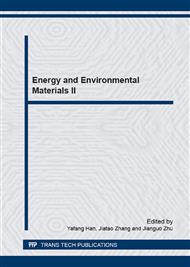[1]
Green M A, Emery K, Hishikawa Y, et al. Solar cell efficiency tables (version 36). Progress in Photovoltaics: Research and Applications, 2010, 18(5): 346-352.
DOI: 10.1002/pip.1021
Google Scholar
[2]
Green M A. Estimates of Te and In prices from direct mining of known ores. Progress in Photovoltaics: Research and Applications, 2009, 17(5): 347-359.
DOI: 10.1002/pip.899
Google Scholar
[3]
Matsushita H, Maeda T, Katsui A, et al. Thermal analysis and synthesis from the melts of Cu-based quaternary compounds Cu-III-IV-VI4 and Cu2-II-IV-VI4. Journal of crystal growth, 2000, 208(1-4): 416-422.
DOI: 10.1016/s0022-0248(99)00468-6
Google Scholar
[4]
Meng X, Deng H, He J, et al. Synthesis of Cu2FeSnSe4 thin film by selenization of RF magnetron sputtered precursor. Materials Letters, 2014, 117: 1-3.
DOI: 10.1016/j.matlet.2013.11.107
Google Scholar
[5]
Katagiri H, Saitoh K, Washio T, et al. Development of thin film solar cell based on Cu2ZnSnS4 thin films. Solar Energy Materials and Solar Cells, 2001, 65(1): 141-148.
DOI: 10.1016/s0927-0248(00)00088-x
Google Scholar
[6]
Wang, W., Winkler, M. T., Gunawan, O., Gokmen, T., Todorov, T. K., Zhu, Y., Mitzi, D. B. (2014). Device characteristics of CZTSe thin film solar cells with 12. 6% efficiency. Advanced Energy Materials, 4: 1301465. doi: 10. 1002/aenm. 201301465.
DOI: 10.1002/aenm.201301465
Google Scholar
[7]
Cui Y, Deng R, Wang G, et al. A general strategy for synthesis of quaternary semiconductor Cu2MSnS4 (M= Co2+, Fe2+, Ni2+, Mn2+) nanocrystals. Journal of Materials Chemistry, 2012, 22(43): 23136-23140.
DOI: 10.1039/c2jm33574c
Google Scholar
[8]
Fries T, Shapira Y, Palacio F, et al. Magnetic ordering of the antiferromagnet Cu2MnSnS4 from magnetization and neutron-scattering measurements. Physical Review B, 1997, 56(9): 5424.
Google Scholar
[9]
Fukushima T, Yamauchi K, Picozzi S. magnetically induced ferroelectricity in Cu2MnSnS4 and Cu2MnSnSe4. Physical Review B, 2010, 82(1): 014102.
Google Scholar
[10]
Koo H J. Density functional investigation of the magnetic superstructure of Cu2MnSnS4. Solid State Communications, 2012, 152(17): 1683-1685.
DOI: 10.1016/j.ssc.2012.04.075
Google Scholar
[11]
Wang S, Gao Q, Wang J. Thermodynamic analysis of decomposition of thiourea and thiourea oxides. The Journal of Physical Chemistry B, 2005, 109(36): 17281-17289.
DOI: 10.1021/jp051620v
Google Scholar
[12]
Wangperawong A, King J S, Herron S M, et al. Aqueous bath process for deposition of Cu2ZnSnS4 photovoltaic absorbers. Thin Solid Films, 2011, 519(8): 2488-2492.
DOI: 10.1016/j.tsf.2010.11.040
Google Scholar
[13]
Himmrich M, Haeuseler H. Far infrared studies on stannite and wurtz-stannite type compounds. Spectrochimica Acta Part A: Molecular Spectroscopy, 1991, 47(7): 933-942.
DOI: 10.1016/0584-8539(91)80283-o
Google Scholar
[14]
He J, Sun L, Ding N, et al. Single-step preparation and characterization of Cu2ZnSn(SxSe1-x)4 thin films deposited by pulsed laser deposition method. Journal of alloys and compounds, 2012, 529: 34-37.
DOI: 10.1016/j.jallcom.2012.03.065
Google Scholar
[15]
Juškėnas R, Kanapeckaitė S, Karpavičienė V, et al., A two-step approach for electrochemical deposition of Cu-Zn-Sn and Se precursors for CZTSe solar cells. Solar Energy Materials and Solar Cells, 2012, 101: 277-282.
DOI: 10.1016/j.solmat.2012.02.007
Google Scholar
[16]
Khadka D B, Kim J H. Study of structural and optical properties of kesterite Cu2ZnGeX4 (X=S, Se) thin films synthesized by chemical spray pyrolysis. Crystal Engineering, 2013, 15(48): 10500-10509.
DOI: 10.1039/c3ce41387j
Google Scholar
[17]
I. V. Pankove, Optical processes in semiconductors, Dover Inc., New York, (1975).
Google Scholar
[18]
Woo K, Kim Y, Yang W, et al. Band-gap-graded Cu2ZnSn(S1-x, Sex)4 Solar Cells Fabricated by an Ethanol-based, Particulate Precursor Ink Route. Scientific reports, 2013, 3.
DOI: 10.1038/srep03069
Google Scholar
[19]
Leitao J P, Santos N M, Fernandes P A, et al. Study of optical and structural properties of Cu2ZnSnS4 thin films. Thin Solid films, 2011, 519(21): 7390-7393.
DOI: 10.1016/j.tsf.2010.12.105
Google Scholar


